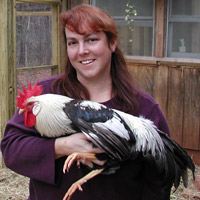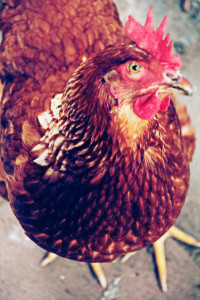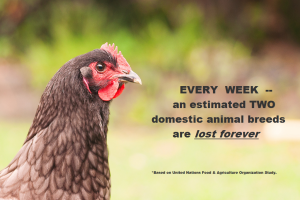UCP Episode 059: The Livestock Conservancy – Saving Heritage Our Breeds (Discussion with Jeannette Beranger)
Description
How many grizzly bears are in the United States? 1,800. How many grey wolves in America? 5,443 in the lower 48 states (there is an estimated additional 7,700 -11,000 in Alaska.) How many Redcap breed chickens in the States? Fewer than 500 (and fewer than 2,000 in the world.)
There are currently twelve different chicken breeds listed as “critically endangered” and an additional twelve breeds on the “threatened” list (fewer than 1,000 in the U.S. and 5,000 worldwide) according to the Livestock Conservancy. While the WWF is fighting to protect pandas and rhinos, the Livestock Conservancy is tirelessly working to protect threatened heritage horse, cattle, donkey, goats, sheep, pigs, chickens, ducks, geese, turkeys and rabbit populations.
Jeannette Beranger, the Research and Technical Programs Manager for the Livestock Conservancy joins me on the Urban Chicken Podcast to discuss the mission of this organization, some of the projects the Conservancy is currently involved in and how backyard hobbyist chicken keepers (like you and me) can help save some rare and special breeds from becoming extinct from our own backyards.
Jeannette has over 25 years of experience working with animals first as a veterinary technician and then later for several years with the Roger Williams zoo, where she eventually became the head zookeeper. For the past few years, Jeannette has worked with the Livestock Conservancy researching, educating, networking and implementing various programs and efforts to save endangered heritage livestock breeds with the Conservancy. She has a depth of knowledge on animals and particularly heritage breed livestock to share on today’s show.
Agricultural systems in the United States (as well as worldwide) have increasingly
become very industrial since the 1950’s “green revolution.” Consequently, industrialized farms utilizing hybridized breeds have replaced the traditional and varied livestock once found in backyards and on small family farms across this nation. Though these “improved” hybrid poultry breeds (e.g. sex-links, ISA Brown, ISA Warrens, Cornish-Crosses, Leghorns, etc.) may grow faster or lay more eggs, they are not necessarily the hardiest or most delicious breeds for the table.
The Livestock Conservancy is working to protect nearly 200 breeds of livestock and poultry from extinction. The organization seeks to save these rare breeds, not by trying to have them replace the hybrid breeds used on large-scale, commercial farms, but rather as complimentary alternatives found on small-scale farms and private lands. The Livestock Conservancy works tirelessly to protect the future of agriculture in the United States through safeguarding the genetically diverse bloodlines found in each of these endangered heritage breeds.
The Livestock Conservancy’s Mission in Action
A three prong approach is used by the Livestock Conservancy in its fight to save our heritage breeds: 1) Discover, 2) Secure, and 3) Sustain. Each of these conservation prongs is crucial to saving rare livestock breeds.
The discover prong means to actually find rare breeds. These rare breeds often have quietly survived for generations until they are found again. Historical research, DNA testing and physical examination and comparison are some of the techniques used in “discovering” rare breeds that need protection.
The second prong, secure, means to safeguard discovered rare breeds from further genetic erosion. This is accomplished mainly through encouraging breeders to save these breeds by continuing to raise and breed them. Conservation of genetically diverse bloodlines within these breeds is crucial as well to prevent inbreeding. Helping breeders to maintain several bloodlines secures these breeds for the future.
The last prong – sustain, is crucial for the continued success of a rare breed. In order to sustain a breed, efforts to grow interest and enthusiasm in the breed, practicing good animal husbandry and helping the breeders find markets for these animals are all necessary to prevent the breed from slipping back into peril of going extinct.
Discover, Secure and Sustain are the three steps that the Livestock Conservancy has used for more than 30 years to enact its mission to ensure the future of agriculture through genetic conservation and promotion of heritage breeds. This organization recognizes the inherent danger in commercial agriculture relying on a very limited genetic pool. Any significant disease or genetic defect in the world of industrial farming could topple that structure. Rare breeds are needed to be available to provide diverse genetic material if the worst should happen.
The Livestock Conservation Priority List & Criteria
The annual priority list of the endangered livestock breeds is based on current populations of that species. In order to get accurate numbers on the existing populations of poultry breeds, a census of hatcheries, major breeders, breed clubs, poultry associations, and Livestock Conservancy members is taken. Additionally the census survey is advertised in magazines to the public at large.
Only breeding stock birds are counted in the poultry census. Consequently, if a person owns just one bird or a few hens with no intention of breeding them, these birds will not be counted in the census. Birds which will not be bred provide no genetic contribution to future generations and are irrelevant to such a census.
There are five levels of priority in breed conservation: 1) critical, 2) threatened, 3) watch, 4) recovering, and 5) study. In order to be place on any of these conservation priority lists, the breed in question must first satisfy certain parameters.
All breeds on each of the five conservation lists must:
- a true genetic breed (i.e. when mated together, a true breed type is reproduced);
- the breed has an established and continuous breeding population in the Uni









